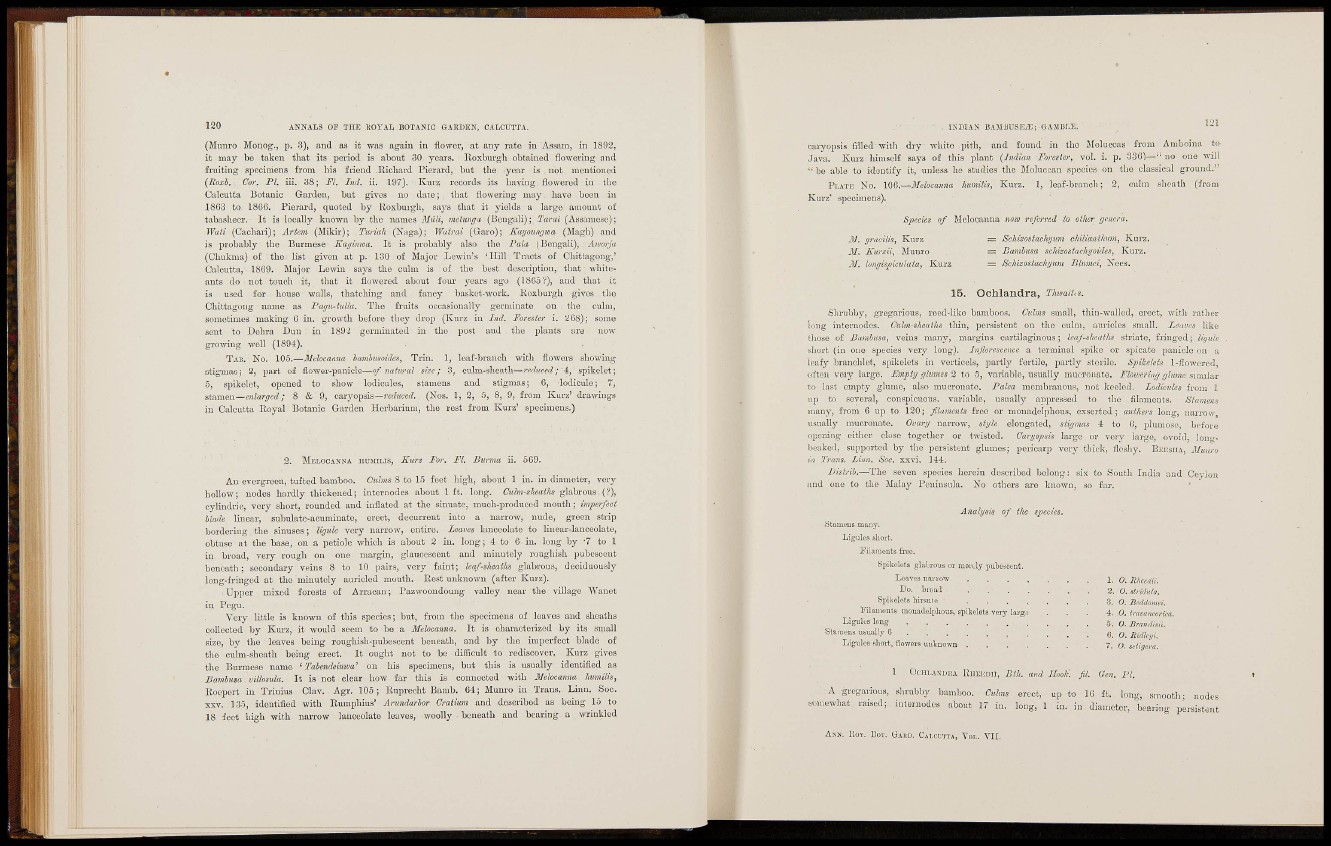
120 ANNALS OP THE KOYAL BOIANIC GAEDEif, CALCUTTA.
(Munro llonog,, p. 3), and as it was again iu flower, at any rate in Assam, in 1892,
it may be taken that its period is about 30 years. Roxburgh obtained flowering find
fruiting spocimeos from his friend .Richard I'icrard, but the year is not lueutioncd
{Roxb. Cor. PI. iii. 38; Fl. Ind. ii. 197). lúirz records its having flowered in the
Calcutta Botanic Garden, but gives no date; that flowering may have been iu
1863 to 1866. Pierardj quoted by Roxburgh, sa3's that it yields a largo amount of
tabasheer. It is locally known by the names MúK, inchinga (Bengali); Tarai (Assamese);
Wati (Cachari); Artem (Mikii-); Turiah (Naga); Wutrai (Garo); Kayoungwa (Magh) and
is probably the Burmese Kayimua. It is probably also the Faia [Bengali), Aioorja
(Chukma) of the list given at p. 130 of Major Lcwin's 'Hill Tracts of Chittagong,'
Calcutta, 1869. Major Lemu says the culm is of the best desciiption, that whiteants
do not touch it, that it flowered about foiu* ¿-cars eigo (1865?), and that it
is used for bouse walls, thatching and fancy basket-work. Roxburgh gives the
Chittagoiig name as Fagu-tulla. The fi'iiits occasionally germinate on the culm,
sometimes makiiig 6 iu. gi-owth before they drop (Kurz iu Ind. Forester i. 268); some
sent to Dehra Duu iu 189¿ germinated iu the post and the plants are now
growing well (189i).
1'AB. NO. 105.—Mclocanna lamhusoides, Trin. 1, leaf-branch with flowers showing
stigmas; 2, part of flower-panicle—of natural size; 3, culm-sheath—míítcác?;'4, spikelet;
5, spikelet, opened to show lodicules, stamens and stigmas; 6, lodicule; 7,
stíimen—enlarged; 8 & 9, caryopsis—reízícef?. (Nos. 1, 2, 5, 8, 9, from Kurz' drawings
in Calcutta Royal Botanic Garden Herbarium, the rest from Kurz' specimens.)
2. MELOCANSA nujiiLis, Kurz For. Fl. Burma ii. 5C9.
An evergreen, tufted bamboo. Culms 8 to 15 feet high, about 1 iu. in diameter, very
hollow; nodes hardly thickened; internodes about 1 ft. long. Culm-slmihs glabrous.(?),
cylindric, very short, rounded and inflated at the sinuate, much-produced mouth; imperfect
Hade linear, subulate-acuminate, erect, decurrent into a narrow, nude, green strip
bordering the sinuses; ligule very narrow, entire. Leaves lanceolate to linear-lanceolate,
obtuse at the base, on a petiole which is about 2 in. long; 4 to 6 in. long by -7 to 1
in broad, very rough on one margin, glaucescent and minutely roughish pubcscent
beneath; secondary veins 8 to 10 pairs, very faint; leaf-sheaths glabrous, deciduously
long-fringed at the minutely auricled mouth. Rest unknown (after Kurz).
Upper mixed forests of Arracan; I'azwoondoung valley near the village Wanct
in Pegu.
Very little is known of this species; but, from the specimens of leaves and sheaths
collected by Kurz, it would seem to be a Meloeanna. It is characteiized by its small
size, by the leaves being roughish-pubescent beneath, and by the imperfect blade of
the culm-sheath being erect. It ought not to be difficult to rediscover. Kurz gi\'es
the Burmese name ' Talendeinwa^ on his specimens, but this is usually identified as
Bamhisa villosula. It is not clear how far this is connected with Meloeanna humilisy
Roepert in Trinius Clav. Agr. 105; Ruprecht Bamb. 64; Munro in Trans. Linn. Soc.
XXV. 135, identified with Rumphius' Arundarbor Cratium and described as being 15 to
18 feet high with narrow lanceolate leaves, woolly beneath and bearing a wrinkled
. I>;DIAN BAJIiiUSE/E; GAMBr-E, 121
caryopsis filled with di-y white pith, and found in the Siokccas from Amboina to
Java. Kiu'z himself says of this plant {Jndim Forester, vol. i. p. 3361—" no one will
" be able to idsntify it, unless he studios the Moluccan species on the classical ground."
P l a t e No. 106.—Meloeanna humilis, Kurz. 1, leaf-branch; 2, culm sheath (from
Kurz' specimens).
Species of Meloeanna now referred to other genera.
M. gracilis, Kurz
M. Kurzii, JIunro
M. longispiculata, Kurz
= Schizostachguni chilianthnm, Kurz.
= Dumhusa schizostachyaides, Kurz.
= ScMzosiackyum Blumei, Nees.
15. O c h l a n d r a , ThwaH'.s.
Shrubby, gregarious, reed-like bamboos. Culm small, thio-walled, erect, with rather
iong internodes. Culm-sheaths thin, persistent on the culm, auricles small. Leaves like
tliose of Bamhusa, veins many, margins cartilaginous ; leaf-sheaths striate, fringed ; Uyule
short (iu one species very long). Inflorescence a terminal spike or spicato panicle on a
leafy branchlet, spilcelets in verticals, partly fertile, partly sterile. Spikeleti 1-flowered,
often very large. Empty glumes 2 to 5, variable, usually mucronate. Flmering glume similar
to last empty glume, also mucronate. Palea membranous, not keeled. Lodicides from 1
up to several, conspicuous, variable, usually appressed to the filaments. Stamens
many, from 6 up to 120; filaments free or monadelphous, exserted ; anthers long, narrow
usually mucronate. Ovary narrow, style elongated, stigmas 4 to 6, plumose, before
opening either close together or twisted. Caryopsis large or very large, ovoid, longbeaked,
supported by the persistent glumes; pericarp very thick, flosliy. BEESIIA, Munro
in Trans. Linn. Soc. sxvi. 144.
nistrih.— n-\e seven species herein described belong: six to vSouth India and Ceylon
and one to the Malay Peninsula. No others are known, so far.
Analysis of the species.
Stamens maiay.
Ligubs short.
Pilaiueots free.
Spikelets glak-ous or raertly pubesceut.
Leaves nnrruw . . . . .
Do. broad
Spikelots hirsu(Q
Filaments inonaclclplious, spikelets very lai-ga
Lignk-s long
Stamens usually 6
Ligules Rlioi-t, flowers iinlsnown . . . . . .
1. 0. Rhcedii.
2. 0. stridttlo.
3. 0. Beddomci.
4. 0. travancoriea.
5. 0. Brandisii.
6. 0. EidleyL
7. 0. seiifjera.
1 UCULANDRA Rheeuji, Btk. and Hook'. Jil. Gen. Fl.
A gregarious, shrubby bamboo. Culms erect, up to 16 ft. long, smooth- nodes
.nucwhat raised; internodes about 17 in. long, 1 iu. in diameter, bearing p^-sistent
Axs, Iloy. Dot. Gaud. Calcutta, Yol. VII.